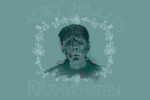When a person stays awake for far too long, they will become aware of a reality invisible to most: a strange door where there was none, a shadow-lined alleyway that only appears at midnight. Behind these mysterious gateways lie the realm of terror known as the Mad City, a sprawling urban monstrosity where Nightmares stalk the streets. This is the setting of “Don’t Rest Your Head,” a horror RPG that puts you at the center of your own dark fairy tale.
Created by Fred Hicks and produced by Evil Hat Productions, “Don’t Rest Your Head” allows players to take on the role of the Awake, people who have stayed conscious long enough to become aware of the Mad City. Here, they face numerous threats, from untiring clockwork cops to monstrous paper boys looking to make the player their next headline.
As the Awake, players must survive and navigate Mad City in order to accomplish some kind of personal goal. Perhaps someone they love has been kidnapped, and they must go to the city in order to rescue them. Or perhaps they recognize someone or something in the city from their past and must search for answers.
Whatever the case, a player’s progress is guided through the aid of a Game Master (GM), who helps set up the different situations players will face and narrates the outcome of a player’s actions.
While it is the job of the GM to develop the story and engage the player with different challenging scenarios, they are by no means in complete control of the game; players also actively contribute to the narrative through creating and developing their characters.
In order to create a character, the game manual recommends players answer five key questions:
What’s been keeping you awake?
This question deals with the pressures the character has been facing in their day-to-day life that have been causing their insomnia. Perhaps the character is responsible for the death of someone they loved or maybe some shadowy organization is after them and they must abstain from sleep in order to stay vigilant.
What just happened to you?
This question sets up the event which introduces the character, which in turn helps determine what their future course might be. The character’s drowsiness may have just caused them to be in a car accident, for example, or perhaps they were fired from their job and are now walking home in despair.
What’s on the surface?
This question is about how the character appears at first glance, which will affect how others interact with them. The character might appear normal despite being sleep deprived, or their exhausted state might be quite obvious.
What lies beneath?
This question probes into how the troubles the character has been experiencing have been affecting them beyond just their insomnia. It gives an idea as to how they are likely to act in different situations. If the character just recently watched their family’s house burn down, for instance, they will likely be very uncomfortable around fire.
What’s your path?
This question asks the player to consider what their character’s goals are, which in turn influence what choices they will make and how their story will eventually end. The character might be looking for someone they know in the Mad City or perhaps they have heard of a person or thing there that can help them with their troubles.
As is likely obvious, “Don’t Rest Your Head” is an extremely character-driven game. Players are challenged to create complex individuals with strong motives and plenty of inner demons. Likewise, GMs are given the task of writing suitably dark scenarios for these characters to struggle their way through.
For aspiring writers, particularly in the horror genre, this can prove an enjoyable and fulfilling exercise. Conversely, even those who hold no interest in writing can still get plenty of thrills out of becoming the main character in a horror story crafted by their friends.
Indeed, this is essentially what “Don’t Rest Your Head” is all about: creating and telling a story. A normal game is played through a series of scenes, in which player characters face different obstacles and must make a variety of tough decisions. Whenever a character enters a conflict, the game’s dice-based mechanics come into play.
Both a player and the GM have a pool of dice from which to draw from. Whenever a conflict occurs, the player and the GM will roll against each other to resolve it. Whoever has the highest degree, or number of dies which land between one and three, is said to be the winner.
There are four types of dice, representing the four main character attributes in “Don’t Rest Your Head”: discipline, exhaustion, madness and pain. Players use the first three types, while GMs only use the latter.
Discipline is a measure of a character’s general skill and self-control. All player characters start with a discipline score of three, meaning they always get to roll three discipline dice. Exhaustion reflects how tired a character is. Each point of exhaustion gives the player a new dice to roll, but it also brings them closer to crashing.
When a character crashes, they might fall asleep, which can prove fatal in Mad City, as it leaves the character vulnerable to its hostile denizens.
Madness represents the damage the character’s mental health has suffered. While the player can roll up to six madness dice, each die added to their pool brings their character closer to snapping.
When a character snaps, they act out of control for the rest of the scene and also lose one of their discipline dice. If a character manages to lose all their discipline, they will become a Nightmare, a horrifying creature doomed to dwell forever in the Mad City.
Finally, pain represents how badly a character is hurt in a conflict. GMs will roll pain dice to represent attacks made by Nightmares and other enemies, as well as injuries received from more risky actions taken by a player character, such as climbing a rickety fire escape or attempting to break down a door.
There are more rules, but the ones outlined here are the most important and should give a general feel for how “Don’t Rest Your Head” is played. Every player character also possesses two special abilities: an exhaustion talent and a madness talent, each of which requires the associated type of dice in order to be used.
An exhaustion talent is a particular skill such as running, fighting or lockpicking, which a character can do especially well the more tired they are. It essentially represents the ability of the Awake to draw strength from their weary state. The more often the character uses their exhaustion talent, the more they will tire, bringing them ever closer to crashing.
A madness talent, on the other hand, is rather like a superpower, allowing the character to do something that would otherwise be impossible including flying, teleporting or turning their flesh to stone. However, the sheer irrationality of being able to perform a madness talent takes a toll on the character’s sanity; if used too often, it could cause the character to snap.
A game of “Don’t Rest Your Head” quickly becomes something of a balancing act. Players must manage their exhaustion and madness carefully while being sure only to engage in conflicts when necessary.
Part of the horror of the game is watching the consequences of your actions unfold in unintended ways. Maybe your character has snapped and is now attacking the person they were trying to save or maybe some impossible action has finally taken too much out of them and they have fallen asleep, becoming easy prey for the Nightmares.
Whatever the case, “Don’t Rest Your Head” offers endless possibilities for storytelling and roleplaying, allowing players to create just about any scenario in Mad City they can dream up. It is also fairly open to those who are new to RPGs and can be extremely rewarding for those who have more experience.
“Don’t Rest Your Head” is a beautifully horrifying roleplaying experience. While perhaps not as well-known as other RPGs like “Dungeons and Dragons,” “Don’t Rest Your Head” nevertheless holds its own through the uniquely terrifying backdrop it provides in the form of the Mad City, where any number of spine-chilling, hair-raising and even heartbreaking stories lie waiting to be told.
So what are you waiting for? Mad City is calling.
















